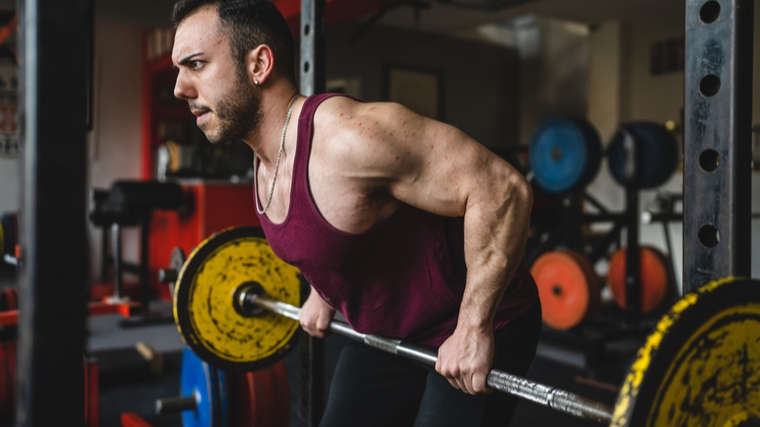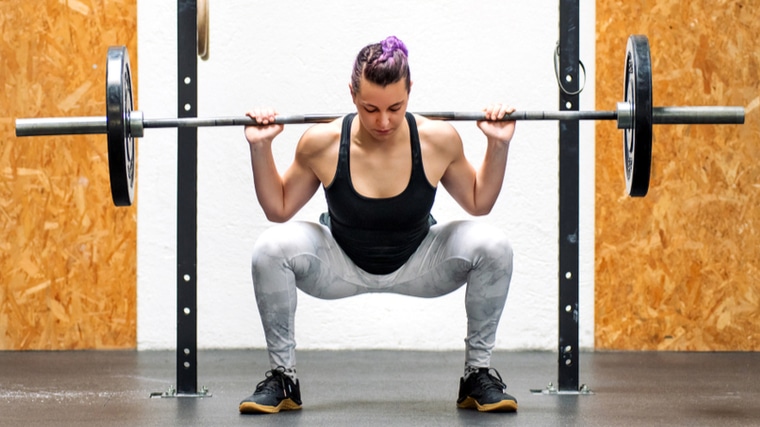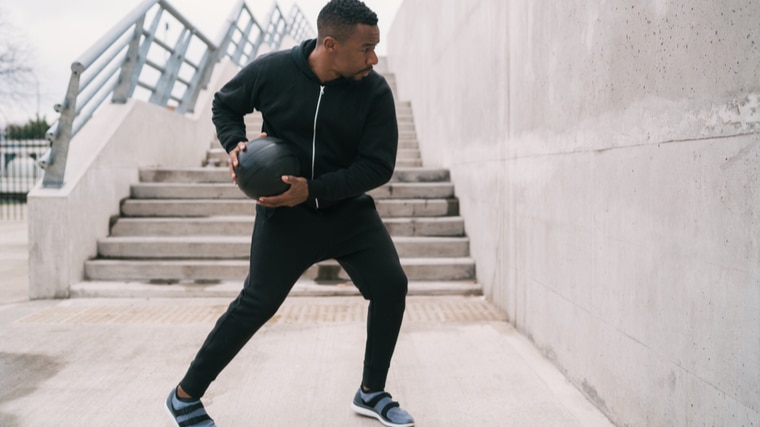Want a more efficient, more effective, more engaging workout? Rest less between sets. More specifically, start using supersets — a common, but often misunderstood and misapplied, intensity-boosting technique. Performing supersets instead of straight sets can help to reduce your training time by nearly 50%. (1) Supersets might even boost performance via a phenomenon called ‘potentiation’ … Read more
The post Supersets Explained: A Technique for Better Results and Less Fatigue appeared first on Breaking Muscle.
Want a more efficient, more effective, more engaging workout? Rest less between sets. More specifically, start using supersets — a common, but often misunderstood and misapplied, intensity-boosting technique.
Performing supersets instead of straight sets can help to reduce your training time by nearly 50%. (1) Supersets might even boost performance via a phenomenon called ‘potentiation’ when used correctly (more on this later).

By integrating cutting-edge strength and conditioning research and applied physiology, you can harness this powerful (and fun) technique. After a brief review of how and why this method works, you’ll discover recommendations for each type of superset and programming guidelines based on your training priority — strength, power, and size. You’ll also find sample supersets to plug into your training split immediately.
- The Three Types of Supersets Explained
- Better Results with Less Fatigue
- Paired Exercises for Power and Size
- Programming Supersets for Your Goals
- Sample Supersets
The Three Types of Supersets Explained
A superset is when you perform one set of an exercise followed by one set of a different exercise with no rest between sets, as opposed to doing an exercise, resting, and then doing another set of the same exercise (known as straight sets). Those two exercises can either be for similar body parts or different body parts.

Supersets can incorporate multi-joint (compound) exercises, single-joint (isolation) exercises, or one of each. The programming specifics will determine your overall results. These distinctions between different types of supersets are not pedantic semantics. There are important differences regarding how the body performs and responds to these techniques.
Agonist-Antagonist Supersets
- What It Is: The most common type of superset includes two exercises that train opposing muscle groups — a chest exercise followed by a back exercise or a quad exercise followed by a hamstring movement. This method is more technically considered an agonist-antagonist superset.
- Why It Matters: Training muscles on opposite sides of the body in superset-fashion may be most intuitive, because it manages fatigue in different muscles. You can minimize peripheral fatigue, the type that develops in engaged muscle fibers, by following this superset structure. However, we must also consider central fatigue, which is related to neurochemical mechanisms in the spinal cord and brain. Training large muscle groups through large ranges of motion and training to failure may accelerate central fatigue.
- Try It: Consider pairing two single-joint exercises or a multi-joint exercise with a single-joint exercise. If you must pair two multi-joint exercises, avoid taking sets to failure. Examples of agonist-antagonist supersets include: Bench press and barbell row, pulldowns and the overhead press, dumbbell curls and triceps pressdowns, leg extensions and leg curls, or chin-ups and lateral raises.
Alternate-Peripheral Supersets
- What It Is: Supersets can also be performed with two exercises that alternate between the upper and lower body movements, technically called alternate-peripheral supersets. (2)
- Why It Matters: Alternate-peripheral supersets are another way to avoid excessive peripheral fatigue. However, because the exercises cover both the upper and lower body, you must also pay attention to synergist muscles that support the body when choosing exercises. An alternate-peripheral superset that taxes the trunk extensors (lower back), such as bent-over rows and deadlifts, will result in poor performance due to low back fatigue. Similarly, avoid pairing abdominal exercises with overhead presses because core stability is essential for safe overhead pressing.

- Try It: To minimize potential issues, consider using a single-joint exercise for the second exercise in any alternate-peripheral superset. Try bench press and leg extensions, Romanian deadlifts and hammer curls, or lunges and dumbbell flyes, or more challenging combinations like squat and bench press or deadlifts and pull-ups.
Compound Sets
What Is It: If you match exercises of a similar type such as horizontal pressing, chest exercises, vertical pulling, back exercises, etc., it’s technically a compound set because you’re training similar muscle groups or biomechanically similar movement patterns. (3)
Why It Matters: Fatigue during compound sets accumulates (or “compounds”) to a greater degree than other supersets because of the similar movements being trained. (3) Because of this increased fatigue, it would be easy to write off compound sets as misguided or ineffective, but physique athletes and bodybuilders have been successfully using this approach for decades as a way to increase training intensity for a specific body part.
Try It: When programming compound sets, be thoughtful about exercise selection. One of the most practical strategies is to pair a multi-joint movement with a related single-joint movement. Ideally, pick a single-joint exercise that trains a body part activated, but not fully fatigued, by the multi-joint movement. For example, it’s safe to hit calf raises after squats or curls after rows, because even a hard set of the multi-joint exercise is unlikely to deplete the muscles emphasized in the single-joint exercise. More challenging examples include overhead presses and lateral raises, cable rows and pulldowns, or incline pressing and dips.
Better Results With Less Fatigue
With every set of any exercise, you stimulate competing aftereffects of both ‘fitness’ and ‘fatigue.’ Fitness refers to the desired adaptations from exercise — increased strength, muscularity, and/or athletic performance. It’s a safe bet that one or all of these are your reason for training in the first place.
Unfortunately, fitness can be obstructed by fatigue — an unavoidable feature of training. (5) While fatigue cannot be prevented, it can be managed and reduced. Appropriately programming your training volume, intensity, and rest intervals can go a long way toward minimizing fatigue.

A recent study examined which of the three types of supersets can best balance fitness and fatigue. They found the greatest drop in power using compound sets, pairing the dumbbell bench press and barbell bench press. Basic straight sets (without supersets) showed the smallest drops in performance.
Interestingly, alternate-peripheral supersets (pairing the squat and bench press) showed greater losses than agonist-antagonist supersets (supersetting the row and bench press).
Session RPE ratings (rate of perceived exertion — how challenging the lifters felt the training was) were highest for compound sets followed by alternate-peripheral supersets, then agonist-antagonist supersets, and lowest for straight sets.
These findings shouldn’t be too surprising to any lifter who’s used supersets. Performing straight sets can be less challenging than alternating exercises, but supersets are more time efficient (leading to the same or better overall results with shorter workouts) and, as you’ll learn in the next section, specifically programmed supersets can actually improve power output.
The study’s differences between the bench/squat and bench/row conditions might be explained by the fact that squats are systemically demanding — that is, they’re just plain hard! Ultimately, this research shows the importance of properly planning your supersets.
Paired Exercises for Power and Size
Back in 2005, research determined that a set of rows performed before a set of bench throws significantly improved power output of the throw. Since the row trained the pulling muscles and the bench throw trained the pushing muscles, this phenomenon can be explained by improved coordination between the agonists and antagonists as a direct result contracting the antagonist muscles. (6)

Now, this was not actually a study in supersets. It’s considered “contrast training,” which is similar to an agonist-antagonist superset, but with more rest between the two exercises. The row was performed, then three minutes rest was provided before the bench throw was tested.
This approach can be adapted to build power with agonist-antagonist supersets. A lifter can structure agonist-antagonist supersets with a ballistic or power-focused exercise performed first, followed by a second exercise training the antagonist muscles. For example, you might combine plyometric push-ups with a chest-supported row.
But why arrange the superset this way when the study performed the explosive exercise second? It’s all about timing. The transition time between superset exercises is too short for high-performance power training.
You will not experience a potentiation effect in the second exercise of a superset, or if you do, it will be masked by general fatigue. Studies consistently report that resting less than 15 seconds between two exercises is insufficient to maintain power in the second exercise. (2)(7)(8)

It’s more efficient to place the explosive exercise as the first movement and allow the second exercise of the agonist-antagonist superset to potentiate the next round. The chest-supported row you did in the first set will boost your plyometric push-up performance in the second set. Just make sure you take a full three-minute (or longer) rest between each pairing.
Now, you might be thinking, “I don’t train with ballistic exercises or plyometrics, I just want to get bigger and stronger. What does this have to do with me?” Potentially, a lot.
If your primary objective is strength, you need to lift heavy loads (at least 80% of your one-rep max or 1RM). Although ballistic exercises aren’t associated with heavy loads, you should be performing each heavy rep with ballistic intent — trying to move as explosively as possible.
Because the load is heavy, it won’t feel or look fast, but your body will be attempting to move the heavy load as fast as possible, which will maximize performance and ultimately lead to greater strength gains.
Lifters with hypertrophy goals will also benefit from performing repetitions with ballistic intent. This technique maximizes recruitment of high threshold motor units, which are pools of muscle fibers with the greatest potential for growth.
To tap into these fibers, you need to train with very heavy loads, train to failure (or very close to failure), or perform reps with ballistic intent. The latter is appealing and highly effective, because you can stimulate high threshold fibers using a wide-range of loads beginning with the first rep of each set.
Programming Supersets for Your Goal
Supersets may be used as a time-saving efficiency technique, an intensification technique, or a potentiation technique, making them suitable for a wide variety of training goals.

Here’s the meat and potatoes of programming supersets successfully. Guidelines are organized into three categories based on your primary training goal: Strength, power, or hypertrophy.
Supersets for Strength
Agonist-antagonist or alternate-peripheral supersets are best for building strength. Train your priority movement first, because you’re likely to get more out of the first exercise in the superset. For example, if you are looking to bring up your bench press strength, place the bench press before the row.
To build pure strength, you need to train with heavy weights using 80 to 90% of your one-rep max. It’s not a good idea to program supersets much heavier than 90% because the intense effort and short-term fatigue makes it an inefficient technique. Save those heavier weights for straight sets. You can and will build strength in this range. (9)
Volume is inextricably linked to load because you can only perform so many reps with a given weight. For straight sets, 80-90% of 1RM may be associated with four to eight possible repetitions. (3) However, supersets are an entirely different animal.
Plan on doing three to five supersets with two to six repetitions per set. Estimate repetitions to failure as you perform your set and end the set when you feel you have two good repetitions in reserve. Leaving two good repetitions in the tank helps to ensure that you can maintain intensity and repetition quality in the second exercise, and in subsequent supersets.
Perform the concentric (lifting phase) of the rep with ballistic intent (i.e. as fast as possible). Control the eccentric (lowering phase) taking one to two seconds to lower the weight.
Take a full three to five minute rest between each superset. If you are tempted to rest less, recognize that your performance is likely to suffer. Research has shown that you lose peak force and power with two minutes rest between supersets. (2)
Take closer to five-minute rests when two multi-joint movements are selected for the superset, especially if one or both involves the lower body, which trains more overall muscle mass, thereby carrying greater recovery demands.
Supersets for Power
The agonist-antagonist superset structure is best, with the higher-priority exercise placed first in the superset. This structure allows your first exercise to benefit from the contrast training potentiation effect previously discussed. (6) Alternate-peripheral superset structure may also be used. For example, you may pair bench press with squats, but again, make sure to place your high priority exercise first.
For power, you should train across a wide range of loads. This will allow you to move light weight quickly and heavy weight with ballistic intent. However, training with light loads may change certain exercises if you are truly training with the intent to maximally accelerate. A light squat (e.g. less than 50% 1RM) performed with ballistic intent becomes a squat jump.

For horizontal and vertical pressing or pulling exercises exercises, medicine ball throws and slams are fun and effective choices for training power on the lighter end of the load spectrum if you have the tools and space.
Hitting two to five repetitions for three to five total supersets, focusing on crisp purposeful repetitions, is a good general target. Be sure to maximize quality of the repetitions by staying much further from failure than you typically would when training for strength or hypertrophy. (3)
If you are using agonist-antagonist supersets to take advantage of potentiation described earlier, use light load for your second exercise (e.g. 50% 1RM) and perform eight ballistic repetitions for three to six supersets.
Perform the concentric phase with ballistic intent, control the eccentric (one to two seconds), and take at least three minutes between each superset to maximize power.
Supersets for Hypertrophy
Training for hypertrophy is where supersets shine brightest. Any superset structure could work. Again, place the higher priority exercise first. For example, if you are supersetting shoulders and triceps exercises and you are most interested in building capped deltoids, you would perform lateral raises as the first exercise and skull crushers second.
Volume-load, or the product of weight lifted and reps, is related to hypertrophy. Your goal should be to maximize this value while maintaining repetition quality. In the superset literature, 65% of three-repetition maximum (3RM) for sets of 10 is a common superset loading scheme. (2,9) It equates to approximately 60% of 1RM. (3)
At 60% 1RM, the average trainee will be able to perform 16 or more repetitions for a straight set. Easy, right? It’s conservative, but not necessarily easy. Due to accumulating fatigue during a superset workout, the number of repetitions left in the tank will drop as you work through your supersets.
When you plan a hypertrophy superset workout right, the first few sets will feel somewhat easy, but you will likely reach failure (or very near failure) for both exercises during your final superset.
Training to failure is not required for hypertrophy, it is simply a byproduct of this training scheme. Pick a repetition volume that leaves three or four repetitions in reserve at the beginning of the superset, so roughly 12 reps per set. Now, attempt to hit that same repetition goal for every subsequent superset in the workout, for three to five total supersets.
This will be challenging, motivating, and brutally effective, as it promotes increased effort as the workout progresses, ensuring high volume-load is achieved.
When sets are taken close to failure, it likely doesn’t matter whether you draw out your reps with a slow tempo or perform them with a controlled and comfortable tempo. Use your preferred rep speed during hypertrophy supersets.
Short rest intervals (e.g. 60 seconds or less) may enhance the metabolic stress experienced by the working muscle, which might promote hypertrophy. (12) Bear in mind, metabolic stress is going to be high during supersets simply based on their structure. (4)
If you are midway through your superset workout and find yourself close to failure or unable to reach your repetition target, take a longer rest interval before adjusting the weights or repetition target. Prolonging rest mid-workout is preferable to failure. Remember, failing before your repetition target means you’ve sacrificed volume-load, a key driver of your gains.
Sample Supersets for Your Training Split
Below are sample supersets consistent with the recommendations above. Plug and play based on the organization of your lifting routine.
View this post on Instagram
Reminders: When programming supersets for hypertrophy, establish a moderate working weight that allows us to reach our repetition target with four repetitions in reserve (RIR). Stick with the established weight and rep scheme throughout the superset, resting longer if needed. When programming supersets for strength, be flexible with volume. End your sets with two RIR and come back to fight another set.
Push-Pull-Legs Split
Agonist-antagonist supersets and alternate-peripheral supersets do not fit well with the popular push-pull-legs structure (except on “leg day”). Despite the potential for fatigue-related loss of performance discussed above, compound sets may still be beneficial, especially to accumulate volume for accessory exercises.
Hypertrophy Focus (Push)
- Seated Dumbbell Press 3 x 10 (14RM)
- Lateral Raise 3 x 12 (16RM)
Rest: Minimal rest between exercises. Up to four minutes between supersets
Strength Focus (Pull)
- Cable Row 4 x 3-5 (6RM)
- Hammer Curl 4 x 5-7 (8RM)
Rest: Up to one minute between exercises. Up to five minutes between supersets.
Power Focus (Legs)
- Clean 5 x 3 (65% 1RM)
- Kettlebell Swing 5 x 8 (Very light weight)
Rest: Up to one minute between exercises. Three or more minutes between supersets.
Upper-Lower Split
For your primary exercises, use supersets to promote agonist-antagonist potentiation. You can also pair a multi-joint exercise with a single-joint exercise.
Power Focus (Upper Body)
- Bench Press 5 x 3 (65% 1RM)
- Bent-Over Row 5 x 8 (50% 1RM)
Rest: Up to one minute between exercises. Three or more minutes between supersets.
Hypertrophy focus (Lower Body)
- Front Squat 4 x 8 (12RM)
- Seated Calf Raise 4 x 12 (16RM)
Rest: Minimal rest between exercises. Up to four minutes between supersets.
Agonist-antagonist supersets also work well for accessory exercises. Hamstring curls with leg extensions play nice together, but be sure to perform them in that order.
Research has shown that trainees were able to perform more volume-load when the superset was structured with hamstring curls before leg extensions, compared to the reverse order. (13) The mechanism is not fully understood, but it works for me.
Hypertrophy Focus (Lower Body)
- Prone Hamstring Curl 5 x 8 (12RM)
- Leg Extension 5 x 12 (16RM)
Rest: Minimal rest between exercises. One minute rest between supersets.
Full Body Splits
The agonist-antagonist supersets from the upper-lower split routine can be programmed as part of a full-body workout. Pairing glute-ham raises or hamstring curls with squats is one of my favorites:
Strength Focus
- Glute-Ham Raise 4 x 5-7 (8RM)
- Back Squat 4 x 3-5 (6RM)
Rest: Up to one minute between exercises. Up to five minutes between supersets.
Alternatively, you can bounce between upper body and lower body during the workout using alternate-peripheral supersets:
Hypertrophy Focus
- Pulldown 5 x 10-12 (14RM)
- Romanian Deadlift 5 x 10-12 (14RM)
Rest: Minimal rest between exercises. Up to four minutes between supersets.
Time to Start Supersetting
Lifters with a wide variety of goals can benefit from supersets. Superset structure can vary widely, and different superset structures lead to different physiological responses. Ultimately, the decision of whether to program agonist-antagonist supersets, alternate-peripheral supersets, or compound sets should be based on your training priorities and program organization. Program supersets correctly and your workout will be efficient and brutally challenging.
References
- Iversen V.M., Norum M., Schoenfeld B.J., Fimland M.S. (2021). No time to lift? Designing time-efficient training programs for strength and hypertrophy: a narrative review. Sports Medicine, 51, 2079-2095.
- Weakley JJ, et al (2020). The effects of superset configuration on kinetic, kinematic, and perceived exertion in the barbell bench press. The Journal of Strength & Conditioning Research, 34, 65-72.
- Sheppard JM, Triplett N. Program design for resistance training. In: Essentials of Strength Training and Conditioning (4th ed). Haff G and Triplett N, eds. Champaign, IL: Human Kinetics, 2016.
- Wallace W., et al. (2019) Repeated bouts of advanced strength training techniques: effects on volume load, metabolic responses, and muscle activation in trained individuals. Sports, 7, 14.
- Bartz D., Bartz A. (2022). Fatigue–enemy or ally? NSCA Coach, 8, 24-27.
- Baker D., Newton R.U. (2005). Acute effect on power output of alternating an agonist and antagonist muscle exercise during complex training. The Journal of Strength & Conditioning Research, 19, 202-205.
- Bevan H.R., et al. (2009). Complex training in professional rugby players: Influence of recovery time on upper-body power output. The Journal of Strength & Conditioning Research, 23, 1780-1785.
- Jensen R.L., & Ebben W.P. (2003). Kinetic analysis of complex training rest interval effect on vertical jump performance. The Journal of Strength & Conditioning Research, 17, 345-349.
- Helms E.R., et al. (2018). RPE vs. percentage 1RM loading in periodized programs matched for sets and repetitions. Frontiers in Physiology, 9, 247.
- Schoenfeld B.J., Ogborn D.I., Krieger J.W. (2015). Effect of repetition duration during resistance training on muscle hypertrophy: a systematic review and meta-analysis. Sports Medicine, 45, 577–585.
- Antunes L., Bezerra E.D., Sakugawa R.L., Dal Pupo J. (2018). Effect of cadence on volume and myoelectric activity during agonist-antagonist paired sets (supersets) in the lower body. Sports Biomechanics, 17(4), 502.
- Schoenfeld BJ (2013). Potential Mechanisms for a role of metabolic stress in hypertrophic adaptations to resistance training. Sports Medicine, 43, 179–194.
- Balsamo S, et al. (2012). Exercise order affects the total training volume and the ratings of perceived exertion in response to a super-set resistance training session. International Journal of General Medicine, 5, 123-127.
Featured Image: Jacob Lund / Shutterstock
The post Supersets Explained: A Technique for Better Results and Less Fatigue appeared first on Breaking Muscle.





